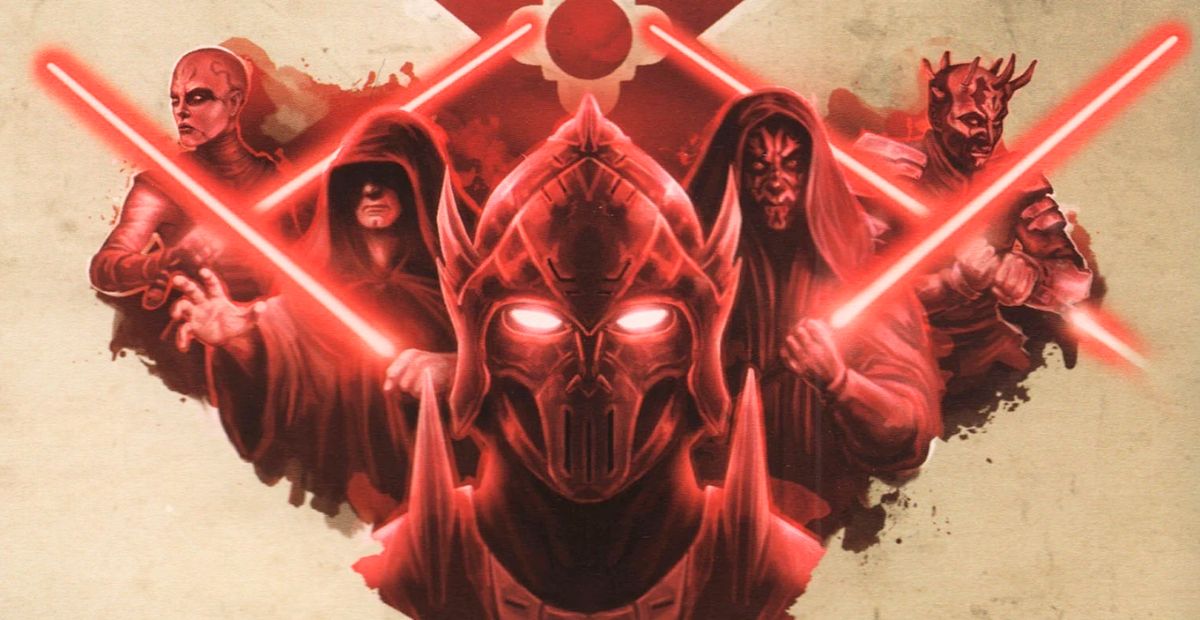In ancient Star Wars history, Darth Bane provided a way to preserve the Sith after their downfall to the Jedi. The Rule of Two designated that only a master and apprentice would exist at one time. It served as a firm decree for the Sith to follow. Yet, it seems like the Rule of Two became guidelines instead.
What Does the Rule of Two Entail?
The Rule of Two goes back to Darth Bane, the lone survivor of the Jedi-Sith 1,000-year war. Bane saw that Sith infighting had weakened the Sith Brotherhood and provided a means for the Jedi to defeat them.
So, Bane decreed the Rule of Two that specifies that “only two Sith Lords must exist at any given time.” This main provision indicates that a master holds the true power of the dark side and an apprentice would seek that power and eventually replace the master.
The Rule of Two is predicated on the older Doctrine of the Dyad that links two Force-sensitive beings in “a unique [and unbreakable] Force-bond.” This doctrine and the relatively later Rule of Two were designed to protect and extend the Sith order.
The video below explores the Rule as a guiding principle for the Sith. As Bane specified, “Two there should be; no more, no less. One to embody the power, the other to crave it.” Although the Rule of Two was riddled with contradictions from its inherent competition, it was designed to be followed to preserve the Sith.
The Rule of Two seemingly establishes a firm set of rules for the Sith. Or, does it?
The Rule of Two Are Guidelines, Not an Actual Set of Rules
The Sith tend to take matters into their own hands and not strictly follow the Rule of Two. It could be Sith “arrogance and self-importance” that leads to breaking the rules, but both Sith master and apprentice “seem to regularly break the rule by training others.”
The Legends’ explanation of the Rule of Two outlines how Sidious broke the rules or treated them more like guidelines. Sidious trained Darth Maul while still serving under Darth Plagueis and then took on two apprentices at the same time–Count Dooku and Fosh Jedi Vergere. Moreover, both Plagueis and Sidious did not truly intend to make Maul a Sith Lord, just use him for their ends.
Dooku likewise took the Rule of Two as guidelines because he did not follow them. As this article captures, Dooku violated the rule by taking on “several apprentices” like Asajj Ventress and Savage Oppress. And, we should keep in mind the Rule failed to prevent infighting, as in Anakin supplanting Dooku.
Although we may think of the Rule of Two as a “strict doctrine,” George Lucas did not intend it to be that way. Lucas thought the Rule should be “a more natural process rather than a decree” that had to be strictly followed by the Sith. By their corrupt and driven nature, the Sith would naturally battle one another for supremacy and thereby leave only two Sith Lords standing.
Hence, the order of the Sith would usually prevail by natural outcome, not by consciously following the Rules. Most posts on this discussion tend to agree with this line of thinking. The Rule of Two may have been “followed” to the extent that apprentices were overthrowing masters, but it served as the shortest pathway to power.
Because of their dark side emotions of hate, anger, and greed, the Sith would have used any means to achieve their desired result. Bending or breaking the Rule, or just seeing as a signpost on the road, speaks to the nature of the Sith.
In addition, the Rule of Two was “inherently flawed,” as this article rightly conveys. The constant double-dealing and back-stabbing of the Sith undermined the very guiding principles that Bane had in mind. Sidious even failed to find a proper successor and cloned himself instead.
The Rule of Two Is No Rule
The Rule of Two may have originated as a firm doctrine to guide the Sith, but from its origin it had problems. The Sith’s lust for power would mean that the Rule would not be adhered to so strictly as planned. Instead, Sith followed it as a guideline to pursue power, not to preserve their order.

